Roger I, a Norman king, invaded Sicily and southern Italy in the 11th century and subdued the Byzantines in southern Italy and the Moors in Sicily. by 1130 his son, Roger II was crowned King of Sicily, having unified the Norman territories. His palace was in Palermo, on the grounds of an earlier Arab fortress but he wanted to add an impressive palace chapel. This chapel is the work of Byzantine and Norman artists as well as Islamic artists from Egypt and the Middle East. The chapel itself shows the influence of these various traditions: Eastern and Western Christianity and Islamic courtly art. It has three apses and extensive mosaics covering the wall, typical in Byzantine architecture, as well as recycled classical columns, seen in western Christian churches. The chapel was dedicated to the two most important saints in western Christianity, Saints Peter and Paul, whose lives are illustrated in the side aisles.
The courtyard with the Palatine Chapel on the second floor (the first floor, piano nobile, in Europe)The outside wall of the chapel is decorated with mosaics by Pietro Casamassima illustrating the Biblical episode of Absalom's rebellion against his father David.
|
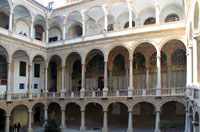 |
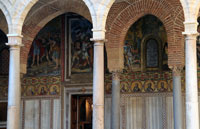 |
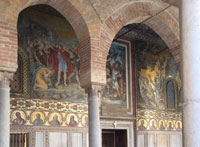 |
| |
|
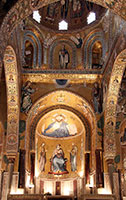 |
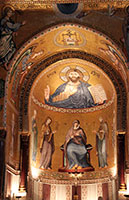 |
The Presbytery with the central apseThe mosaic of Christ Pantokrator in the top register is essentially medieval although the figures in the lower register have been extensively restored and changed. |
| |
|
The Presbytery is the square space separated from the central nave and the apse behind it. In the area above the apse the Annunciation is depicted although Mary and Gabriel are very widely separated. Between them then we can see the dove of the Holy Spirit and the hand of God extending from a heavenly orb. Christ Pantokrator in the apse semi dome is located where there was once a window; he holds an open book with the inscription, "I am the light" which seem an apt reference since light once came through a window. Above his head important symbols reference to Christ's death, the only reminder in the chapel. The medallion contains symbols of the Passion: crown of thorns, cross, spear, sponge soaked in vinegar. The dove representing the Holy Spirit stands at foot of cross.
|
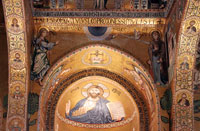 |
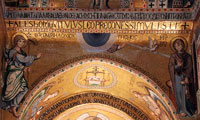 |
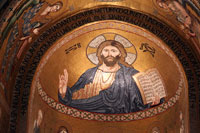 |
| |
|
The domeFrom technical and artistic point of view the mosaics of the dome are considered to be the best. Four full height figures circle the dome: David, much restored, John Baptist, Solomon, and the prophet Zechariah, Then between them are busts of eight prophets holding scrolls. Eight angels are also around the dome, four of whom are identified as archangels: Michael, Gabriel, Raphael, Uriel. Christ Pantokrator is in the center. Left: niches with Evangelists in niches and standing figures; center: circle of angels; right: Michael, the archangel |
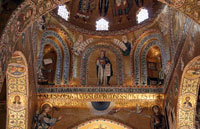 |
 |
 |
| |
|
A niche with an Evangelist, partly visibleThe dome rests on a cylindrical tambour--a circular wall. Four niches are opened in it with mosaics depicting the four evangelists. |
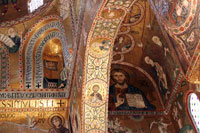 |
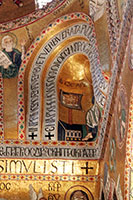 |
| |
|
The chapel is basically a basilica with three aisles, each ending in an apse, and very shallow transepts. The north apse depicts the Madonna and Child with John the Baptist and St. Andrew is in semi dome. This mosaic has been restored and it may have originally been St. Peter for the balance with the south apse which contains St. Paul. Andrew, regarded as the founder of the church in Constantinople, represents eastern Christianity.
|
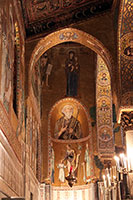 |
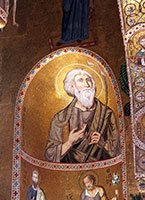 |
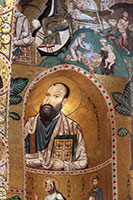 |
| |
|
Looking back to the rear of the chapel with the marble throne platform and wall with inlaid marbleIt is thought that King Roger II and later Norman kings received guests in the chapel with this platform serving as an impressive throne room. The mosaics above also emphasize the king's divine power. The lions are heraldic animals for Norman kings and above them Christ Pantokrater, the all-powerful Christ, is enthroned with saints Peter and Paul flanking him and at top corners the archangels Gabriel and Michael look down. This mosaic serves to legitimize the Norman kings, conveying divine power on their earthly representatives.
|
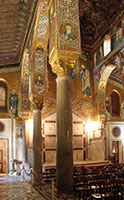 |
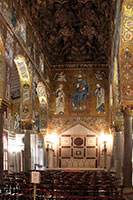 |
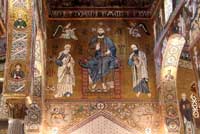 |
| |
|
Elegant inlaid stone designs as a backdrop for the throne |
 |





















